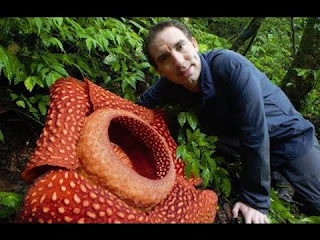After searching the internet for long hours about the fictitious as well as suspicious Blue Rafflesia Raj and Rohit found no reliable information regarding the plant. However, there is a lot of information about Rafflesia and its recognized species. In a gist which can be delineated below:
The Rafflesia is a member of the Rafflesiaceae family and is one of the world’s largest flowers. Rafflesia arnoldi, which is a species of Rafflesia can grow up to 150 cm in diameter which entitles it the largest flower in the world.
Rafflesia arnoldi was first identified in Sumatra by an exploration party led by Sir Stamford Raffles, his wife Lady Sophia Raffles, and his doctor and naturalist Dr. Joseph Arnold. They visited the Pulau Lebar on the Manna River on either 19 or 20 May 1818.
At the time of their visit a local servant first discovered a very large flower and led Dr.Arnold to it. Arnold thus became the first person from the exploration party to see the Rafflesia. The flower was large, measuring a full yard across. Dr. Arnold described seeing “a swarm of flies hovering over” the flower and laying their eggs in it, and it produced “precisely the smell of tainted beef”. He proceeded to remove the flower and sent the specimen back to Manna, but the specimen was later found to have turned brown and infested with maggots. In addition, he also made a coloured drawing of the flower.
The Rafflesia is found in the tropical rainforests of Borneo, Sumatra, Java, Peninsular Malaysia, Thailand, and the Philippines. It occurs only in certain habitats as a parasite on the Tetrastigma species of woody vines.
It is a very rare flower, difficult to reproduce in laboratories and its dried specimen is difficult to preserve. The Rafflesia can measure between 36 to 42 inches in diameter and weigh between 9 to 12 kg.
Since all the plants of this family are parasitic, they do not have any roots, stems, or leaves and lack chlorophyll. Individual flowers or buds simply sprout on the species of Tetrastigma woody vines. Some flowers are monoecious, with both sexes in the same flower.
Prior to the discovery and introduction of this flower to the western world, the indigenous communities who had known about its presence were using the Rafflesia for medicinal purposes. Rafflesia buds were used by women to stop internal bleeding and shrink the womb after childbirth.
In particular, it was used as a love potion and to hasten childbirth by the Sakai tribes in Malaya, and as an aphrodisiac and astringent by high society women in Java.
In spite of its various uses, the chemical composition of Rafflesia flowers has not been extensively analysed yet. However, preliminary phytochemical screening has shown no evidence of the flowers’ medicinal properties. On the contrary, the buds and flowers have a high content of tannin and phenols that can be toxic when taken in large quantities.
In Thailand, young buds of the flower are eaten as a delicacy.
The scent of Rafflesia which varies in intensity from one species to another is just like rotten meat and as a result, it attracts carrion flies. The smell is maximum at around noon and on the third or fourth day of the bloom. That is why this plant is also referred to as "corpse lily” and “carrion flower” in English.
This species is often confused with another species known as Titan arum which is referred to as “corpse flower,”
Rafflesia has never been cultivated in captivity. Even after 180 years of its discovery lot of features, behaviors, phenology, and genology of the species is unknown. The main reason for this is their rarity. These flowers are only found in remote areas in the forest of South East Asia. As the forest cover is decreasing the occurrence of this species in wild is also decrementing. The buds are harvested and sold for their purported medicinal qualities and as a result, even if the flower is visible in some places it is not guaranteed that they will be available in the same place next year due to lack of protection.
So from the gist, it can be well understood that the Rafflesia itself is very rare. Till now 17 different species of Rafflesia have been discovered all of which are extremely rare and their occurrence in the same location is not assured. Now Blue Rafflesia is never been seen neither in wild nor in captivity. So it is indeed a fictional species as informed by Mr.Gomez.
Raj and Rohit were exhausted after a long day in front of their Laptops. So they were having a cup of tea to re-energize themselves. They were discussing the mysterious images of Blue Rafflesia and the images of the species sent to Mr.Gomez when the phone rang multiple times. Raj picked up the call.
"Images are authentic" yelled Mr.Gomez at the other side of the call. "The emails were sent from someone who had opened his email account from Bhubaneswar. Further investigations are going on. Just now Cybercrime and Forensic dept informed me. I will come in the evening to discuss one more piece of news that I have received from my sources.". With this, Mr.Gomez put down his phone.
My first tryst in storytelling. If possible give some feedback, please.
Reference

No comments:
Post a Comment